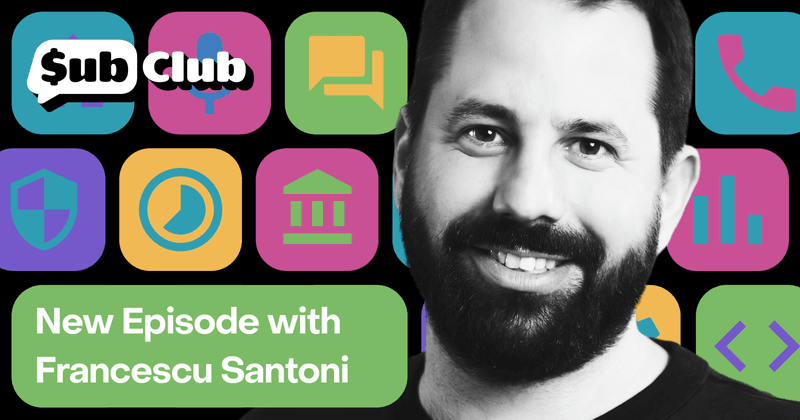“Focus on the problem that you are really passionate to solve” — Francescu Santoni, Mojo
How Mojo grew to over $1M in MRR, the most impactful pricing and paywall experiments, and why it’s important to choose complexity instead of just letting it happen.

These days, video-based social media platforms like Instagram and TikTok are some of the most popular apps in the world. Creators and influencers are publishing increasingly high-quality video content, which has created a market for innovative, easy-to-use video editing mobile apps.
Mojo is an app for creating and editing social video content. With thousands of templates, animations, and layouts, Mojo makes it easy to create high-quality videos for reels and stories. And with over 40 million downloads and a 4.9 rating on the App Store, it’s clear users love it.
This week on the Sub Club podcast, we chatted with Mojo CEO and co-founder Francescu Santoni about how Mojo grew to over $1M in MRR and the lessons mobile app developers can learn from his success.
Don’t stick with a bad idea
We’ve talked before about the importance of recognizing when an idea isn’t working and moving on to something else. Before Mojo, Francescu worked on an augmented reality (AR) app. At the time, the technology was new and exciting, and the app received hundreds of thousands of downloads in just a few months. But, as Francescu points out, it’s better to have 100 users who absolutely need your product than a million users who only like your product but don’t come back. “We couldn’t crack any engagement metrics like retention or stickiness,” he said. “At some point we realized it was too early for AR to take off.”
Francesco and his team made the difficult decision to shut down the AR app and refocus their efforts on video — and Mojo was born.
Virality is cheaper than paid acquisition
Marketing is one of the biggest challenges of creating a successful app business. Paid acquisition can be expensive, and attribution (especially post-ATT) is tricky. But the Mojo team avoided a lot of the financial and technical challenges of user acquisition by building virality into the Mojo app.
“In the beginning, we spent zero dollars on ads,” Francescu said. “Why? Because we basically invented animated posters in stories. When people saw a random guy posting a super great video (like an animated poster on Instagram), they would ask in the DMs, ‘How did you do that?’”
Depending on the type of app you’re building, it might make sense to spend money on ads, but keep in mind that heavy ad spend can hide a lack of product-market fit. It’s better to build social sharing into your app first to take advantage of free viral moments before considering paid acquisition.
Annoy people with your prices (no, really)
Another important lesson Francescu learned: If no one complains, you’re underpricing. In fact, a Mojo customer actually reached out and told him the price was too low! “I got a user telling us we should charge way more so there would be less users using Mojo Pro and the top templates — so they could stand out more on social media,” he said.
The customer makes a good point. Power users are often willing to pay more for your product and for the exclusivity of features available at a higher price tier. Casual or free users, on the other hand, probably should balk at your prices. Be strategic about who you upset with your pricing.
Francescu eventually did raise prices (by nearly 50%), and Mojo is now doing $1M in MRR.
Pick your complexity battles
No matter how you slice it, building a subscription app business involves a lot of complexity. (If it was easy, everyone would do it.) But it’s impossible to tackle every challenge at once — you have to choose which areas of complexity to focus on.
As you make this decision, think about what will have the biggest impact. For Francescu and his team, CRM was a high-complexity problem with low payoff: it would be difficult to squeeze double-digit growth out of CRM. On the other hand, implementing AI in video editing was a high-complexity problem with huge potential payoff. Many see AI as the future of video editing and a major differentiator. By playing to his team’s strengths, Francescu is leading Mojo to long-term success.
You might also like
- Blog post
RevenueCat Paywalls: Now even more flexible with v2
A new editor, more flexibility, and full control over your paywall’s design.
- Blog post
Implementing in-app purchases and monetizing your Roku app: A step-by-step guide
A comprehensive guide to implementing and monetizing your Roku channel, from choosing the right strategy to technical tips and integration best practices.
- Blog post
How we built the RevenueCat SDK for Kotlin Multiplatform
Explore the architecture and key decisions behind building the RevenueCat Kotlin Multiplatform SDK, designed to streamline in-app purchases across platforms.

